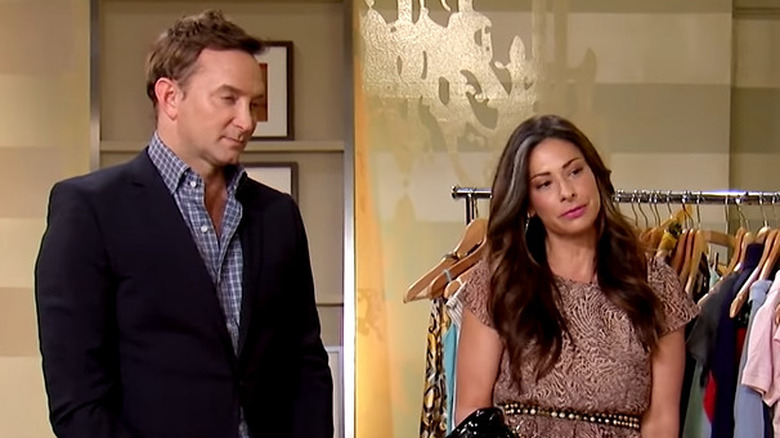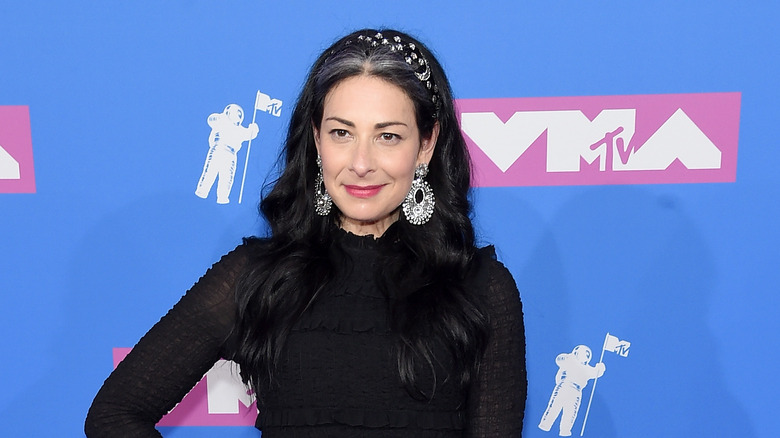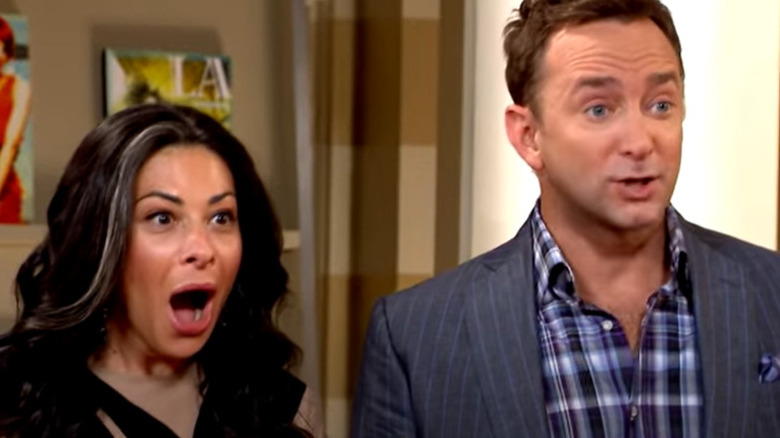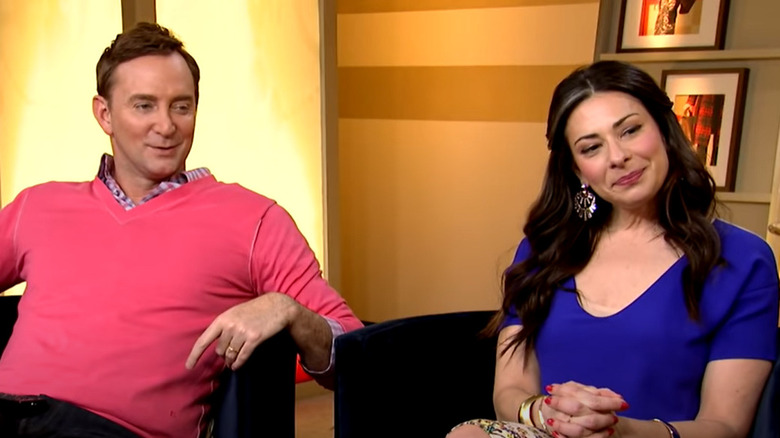The Real Reason Why TLC Canceled What Not To Wear
For many viewers, "What Not to Wear" was an accessible and fun way to learn about everyday fashion. Although the formula remained the same for each episode, there was something undeniably cathartic and cozy about watching everyday women get the confidence boosts they deserved. The chemistry between co-hosts Clinton Kelly and Stacy London was the cherry on top, as their commentary and guidance made a basic makeover show something inspiring and joyful.
TLC announced in 2013 that its iconic makeover show would be canceled after wrapping up its 10th and final season, as noted by The Hollywood Reporter. After a decade of Kelly and London changing lives and wardrobes, an era had come to a close with a statement released by TLC's general manager at the time, Amy Winter. In the statement, Winter announced that "we felt that it was the right time to end the series." There was, and is, little information as to why the network decided to end the show which has kept fans puzzled over what could have led to the decision to cancel it.
Ultimately, the real reason that "What Not to Wear" was canceled might be a combination of several factors, including differences between the hosts and declining viewership. Was it really "the right time," or was there another reason as to why the 10-year series was canceled? In 2019, TLC announced that "What Not to Wear" was being revived, as reported by Variety, which leaves the question of what changed in the six years since the show went off the air?
Difficult fashion victims
The women who were nominated for makeovers by Clinton Kelly and Stacy London came from all walks of life. Some fashion victims, or "contributors," as they were called, didn't quite get with the program. The show's format was ripe with difficult transitions, including a section of every episode where London and Kelly would go through the contributor's current wardrobe and throw away all of the clothes that were deemed unstylish. In the 360-degree mirror, the hosts would walk the contributor through the process of critiquing their style, which could get a bit messy.
In an interview with "Today," Kelly talked about his worst interaction with a contributor named Megumi, in which she told him "you could use some Botox yourself" when the conversation in the 360 mirror became heated. "I'm not sure I could do that show for another year if I had to," he said in that interview. "Once you've told me I need Botox, we're done."
One of the key elements of the show's success was the willingness from contributors to ... contribute. In an interview with Media Beat, London explained that "you get as much out of it as you put into it." Kelly explained in an interview with Statesman that during the show, "We're dealing with people who didn't want to be made over ... I never felt good about that. I wanted to help people that wanted to be helped."
What Not to Wear was getting monotonous
After the announcement came out that "What Not to Wear" had been canceled, Clinton Kelly revealed in an interview with "Today" that he felt the format was becoming tedious, especially after 10 years. "It gets to a certain point where it's monotonous. You know, don't get me wrong, everybody's story is a personal one and every week is different," he said. "But I just sort of found myself rolling my own eyes at my own words as they're coming out of my mouth, like, 'How 'bout you try a structured jacket?' 'How 'bout dark-washed jeans?' 'How 'bout a ballet flat?'"
London revealed similar opinions about the structure of the show in her interview with Media Beat, when she told a reporter, "I gotta say, after 9 years, it pretty much is clockwork." To freshen up the format of the show in the last season, many new episode premises were introduced that deviated from the "frumpy turned glamorous" narrative. The 10th season featured celebrity makeovers, a triple makeover for a group of friends, and a makeover for twins. When discussing the final season with People, London told reporters, "I do love that we are going out with a bang."
The hosts' views on fashion changed
Fashion trends have drastically changed since "What Not to Wear" began in 2003. Looking back at old transformations, one can find an abundance of chevron print, garish florals, and stiff polo shirts. As the show continued to evolve over time, so did the hosts' views on personal style.
In an interview with People in 2019, Clinton Kelly shared, "I'm not even sure 'What Not to Wear' could even be done today, the world is a different place. People dress differently now than 10 years ago." He continued, "There are no rules. You should be wearing what makes you feel good about yourself."
Stacey London similarly spoke on how her style and views on fashion have changed in an editorial piece she did for Refinery29 in 2017. In her article, she discussed how gender norms influenced the way she used to dress when she was on the show, whereas more recently she has adopted a more androgynous style. London reflected on her change in personal style and how these changes related to her time on the show. "There have been times when I've worried this [style] change won't sit well with fans of my old look, that I've ostracized them, that I am no longer playing by the rules I prescribed to countless women over the course of the show," she wrote.
What Not to Wear's viewership was dropping
As reported by Deadline, TLC's viewership was steadily dropping by the time "What Not to Wear" was canceled, since as early as 2010. From its inception, TLC found great success in reality television shows, such as "Trauma: Life in the ER," which ran from 1997 to 2002. In 2012, TLC's president, Eileen O'Neill, expressed the channel's vision to a reporter for The Washington Post. "The aim is for the audience to come away with something of value and interest," she said.
In the early 2000s, reality television was taking the country by storm, and audiences loved to tune into the characters that could be found in obscure and mundane settings alike. As the 2000s transitioned into the 2010s, however, those viewer preferences began to favor the burgeoning industry of scripted shows. AMC's "Mad Men" and "Breaking Bad" began to intrigue viewers more than wacky stories of reality TV, and networks began to see a preference for scripted shows with high production quality.
While A&E and other networks at the time began rerouting funding into scripted television series, TLC stuck to its roots in reality TV. By the time other channels had found security in new ventures, TLC began to steadily lose viewers from 2010 to the point where executives decided to cancel "What Not to Wear." In 2012, the damage had already been done, and the fashion makeover show found itself on a sinking ship.
TLC's General Manager Amy Winter was focused on taking new approaches
With viewership rapidly dropping for TLC's reality TV shows, TLC's General Manager, Amy Winter, revealed in an Q&A with CableFAX in 2011 that she wanted to focus on "exciting new content." Winter was hired in 2008 as General Manager in order to increase brand awareness, according to The Hollywood Reporter. With mounting pressure to increase viewership, Winter may have considered cancelling "What Not to Wear" to focus on newer content.
Newer content to the channel at the time included shows with more controversy such as "All-American Muslim" and "My Big Fat American Gypsy Wedding." In her interview with CableFAX, Winter also emphasized that the channel was planning "to continue to dominate in all things wedding." While TLC may have found a comfortable niche in reality shows that catered to women's interests, advertisers in 2012 were seemingly more interested in working with brands that had a more diverse range of shows that could adapt to changing markets (via The Washington Post).
The feud between Clinton Kelly and Stacy London
After the show ended in 2013, hosts Clinton Kelly and Stacy London went their separate ways, with Kelly focusing on his role as co-host of the daytime talk show "The Chew" and London soon returning to personal styling in TLC's "Love, Lust, or Run." In 2017, Kelly realized a lifetime dream of his and published his collection of personal essays titled "I Hate Everyone, Except You." In this memoir, Kelly described his relationship with London as such (via Inquisitr): "I either adored her or despised her, and never anything in between." Not long after the book was published, Kelly revealed a screenshot via Twitter that showed that he had been blocked by London, as noted by Bustle. After the tweet went viral almost instantly, Kelly discussed the surprise on "The Chew," where he told his co-hosts "it was like getting a little slap in the face," according to Bustle.
In January 2018, London posted a screenshot of her unblocking a blurred name to her Instagram account. In her caption, she wrote, "Forgiveness is something you give yourself to move on, to find peace, to let go. So I unblocked a bunch of people today. If this resonates, maybe you can too." While many fans speculated that London had unblocked her former co-host, Kelly revealed in an interview by People in 2019 that he was still blocked by London at that point. "And guess what? I really don't care," he said in the interview.
Viewers were finding fashion advice elsewhere
The main reason the show was canceled in 2013 seems to be from a combination of different factors, including pressure to increase viewership, conflicting personalities, and the hosts' desires to move onto new endeavors.
During the Edinburgh TV Festival in August 2020, the new General Manager for TLC, Howard Lee, discussed the difficulties of fashion makeover shows in terms of maintaining loyal viewership. "Makeover is a hard area when it pertains to fashion. Fashion is something that's very easily explored online and elsewhere, so often it is difficult to create episodic storylines around that. Commissioning wise, we would not want a flood of makeover or fashion shows," he told reporters (via Realscreen).
As fashion resources became more accessible online, former devotees of "What Not to Wear" may have been looking to sites such as Pinterest and Tumblr rather than relying on cable television, contributing to the decline of viewership overall.
TLC wants to bring What Not to Wear back
Successes with reality show revivals for "Trading Spaces" and "Queer Eye" have undoubtedly inspired the drive to bring about more revivals of classic reality TV (via Refinery29).
Since Clinton Kelly confirmed in 2019 that Stacy London had not unblocked him following the public controversy, audiences may assume that the former co-hosts will probably not be working together for this revival. Changes in casting for revivals have also led to speculation that Kelly and London may not even be offered their former hosting positions in favor of recasting the show entirely, as seen in "Queer Eye," which boasted an entirely new cast when it was revived.
Despite an update via the Edinburgh TV Festival in 2020 that the postponed revival was still in the works (via Realscreen), no casting decisions have been released since then. Nevertheless, audiences can still hope to find that warm and fuzzy feeling from watching people's lives transform in the span of one episode. Although nothing could replace the nostalgia and charm from the "What Not to Wear" we know and love, the revival is a chance for viewers to get excited all over again for a new season of makeovers.








